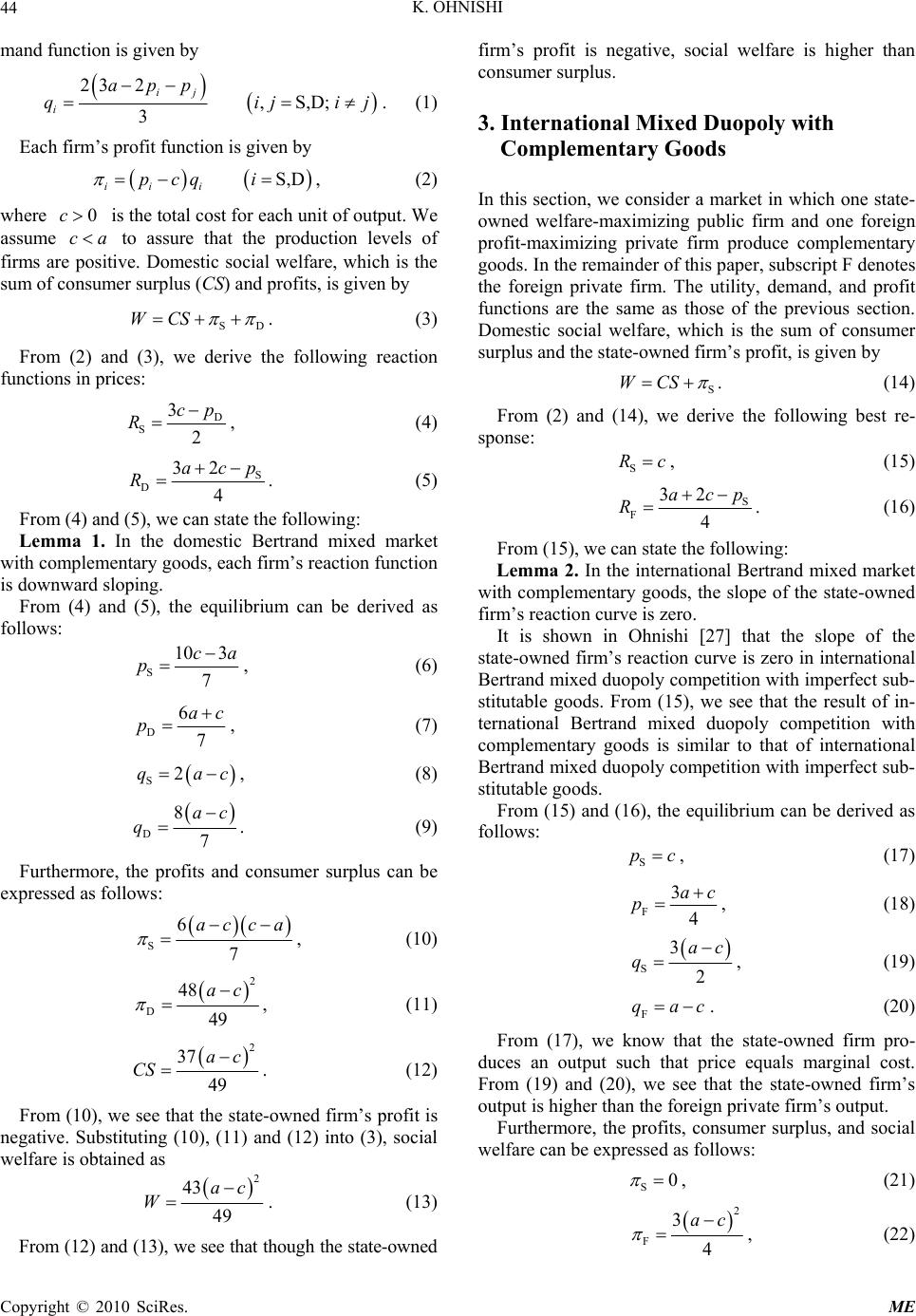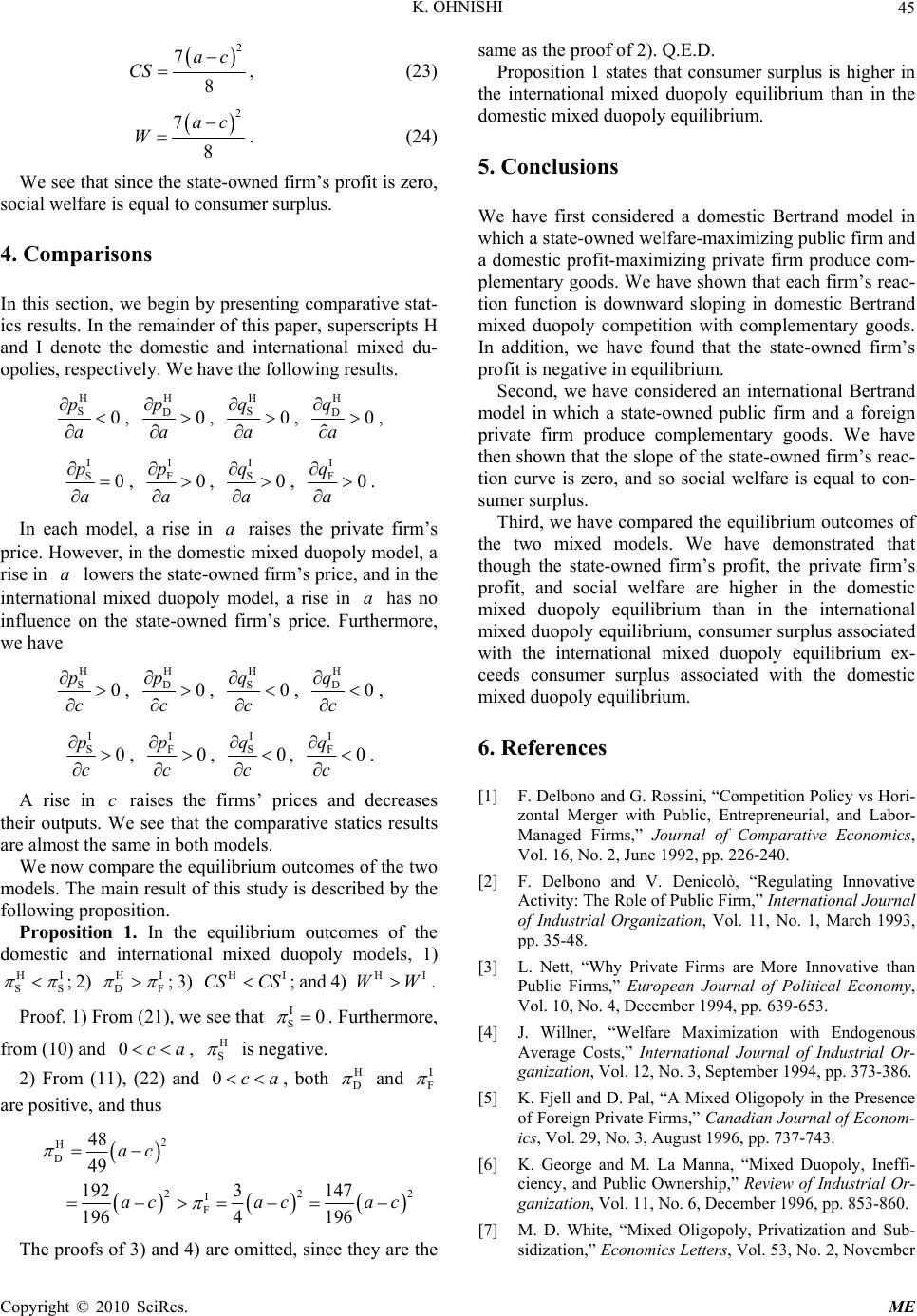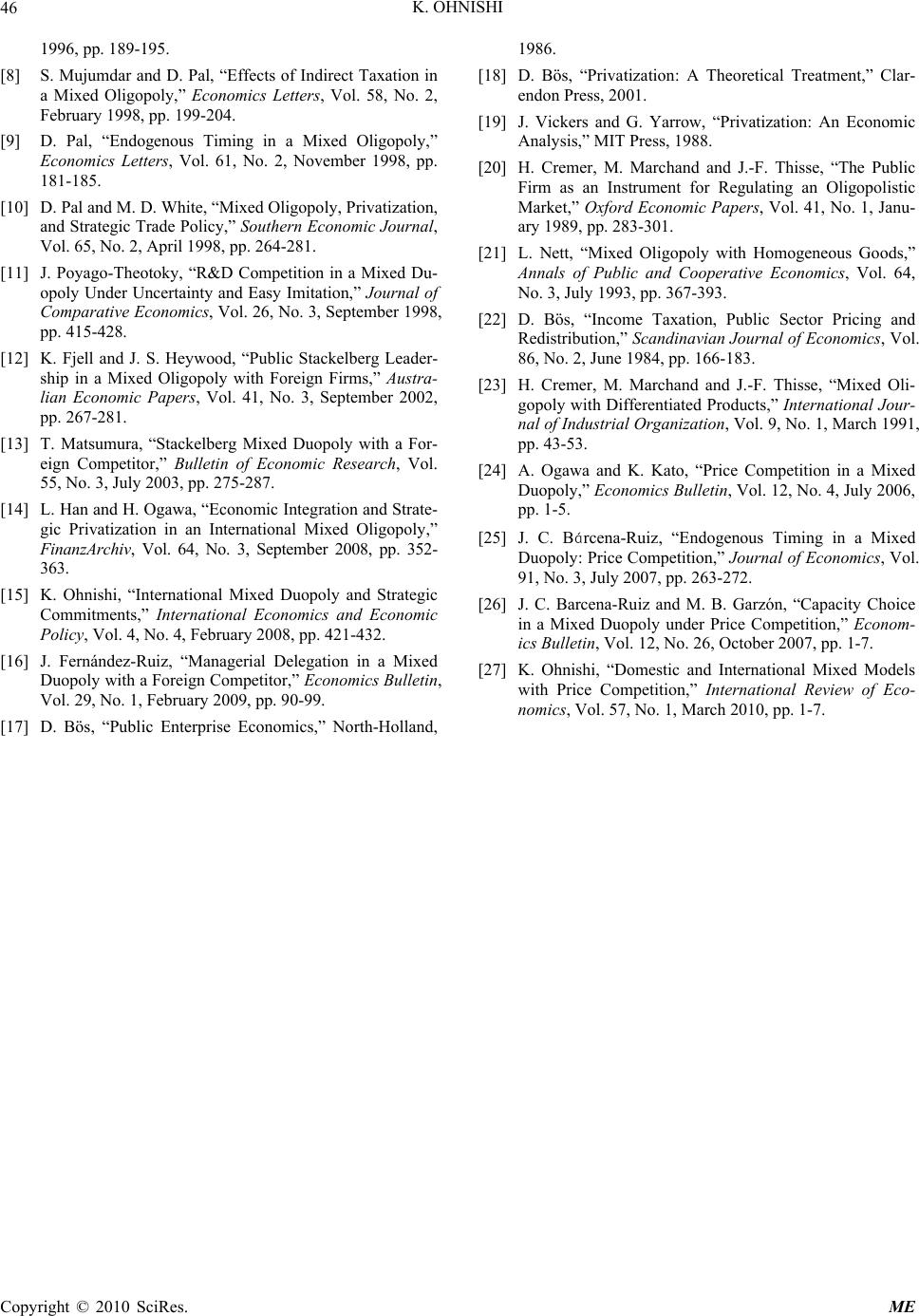Paper Menu >>
Journal Menu >>
 Modern Economy, 2010, 1, 43-46 doi:10.4236/me.2010.11003 Published Online May 2010 (http://www.SciRP.org/journal/me) Copyright © 2010 SciRes. ME Price-Setting Mixed Duopoly Models with Complementary Goods Kazuhiro Ohnishi Institute for Basic Economic Science, Osaka, Japan E-mail: ohnishi@e.people.or.jp Received March 4, 2010; revised March 25, 2010; accepted April 5, 2010 Abstract This paper considers domestic (resp. international) Bertrand mixed duopoly competition in which a state- owned welfare-maximizing public firm and a domestic (resp. foreign) profit-maximizing private firm pro- duce complementary goods. The main purpose of the paper is to present and to compare the equilibrium outcomes of the two mixed duopoly models. Keywords: Complementary Goods, Price Competition, Domestic Mixed Duopoly, International Mixed Duopoly 1. Introduction The analysis of mixed market models that incorporate state-owned welfare-maximizing public firms has received considerable attention in recent years and has been widely performed by many researchers. However, most studies consider quantity competition, such as [1-16].1 Some studies consider mixed markets with price com- petition, such as [22-26]. These studies examine price- setting mixed market models with domestic firms and do not include foreign firms. Ohnishi [27] considers an in- ternational mixed market in which a state-owned public firm competes on price with a foreign private firm. However, this study examines mixed duopoly competi- tion in which public and foreign private firms produce imperfectly substitutable goods. To the best of my know- ledge, the analysis of international Bertrand mixed mar- kets with public and foreign private firms producing complementary goods has been ignored. Therefore, we analyze the behavior of a state-owned public firm and a foreign private firm in an international price-setting model with complementary goods. We con- sider both domestic and international mixed duopoly models with complementary goods. The main purpose of this paper is to present and to compare the equilibrium outcomes of the two mixed duopoly models. The remainder of the paper proceeds as follows. In Section 2, we formulate a domestic Bertrand mixed du- opoly model in which a state-owned public firm and a domestic private firm produce complementary goods. We show the slope of each firm’s reaction curve in the do- mestic Bertrand mixed duopoly model with complemen- tary goods. We present the equilibrium outcome of the domestic Bertrand mixed duopoly model with comple- mentary goods. Section 3 analyzes the equilibrium out- come of an international Bertrand model in which a state-owned public firm and a foreign private firm pro- duce complementary goods. Section 4 compares the equilibrium outcomes of the two mixed duopoly models. Finally, Section 5 concludes the paper. 2. Domestic Mixed Duopoly with Complementary Goods In this section, we consider a market in which one state- owned welfare-maximizing public firm and one domestic profit-maximizing private firm produce complementary goods. The basic structure is from Bárcena-Ruiz [25]. In the remainder of this paper, subscripts S and D denote the state-owned firm and the domestic private firm, re- spectively. There is no possibility of entry or exit. On the consumption side, there is a continuum of consumers of the same type whose utility function is linear. The repre- sentative consumer maximizes , where is the amount of good and is its price SDSS DD ,Uq qpqpq ii p i q DS,i. The function is quadratic, strictly concave and symmetric in and : Uq q SD ,q S D q SD ,Uq q 2 SSD q qqq 2 20a SD qD aq , where . The de- 1See, for example, [17-21] for excellent surveys.  K. OHNISHI 44 mand function is given by 23 2,S,D; 3 ij i app qij ij D . (1) Each firm’s profit function is given by S,D ii i pcq i , (2) where is the total cost for each unit of output. We assume to assure that the production levels of firms are positive. Domestic social welfare, which is the sum of consumer surplus (CS) and profits, is given by 0c ca S WCS . (3) From (2) and (3), we derive the following reaction functions in prices: D S 3 2 cp R , (4) S D 32 4 acp R . (5) From (4) and (5), we can state the following: Lemma 1. In the domestic Bertrand mixed market with complementary goods, each firm’s reaction function is downward sloping. From (4) and (5), the equilibrium can be derived as follows: S 10 3 7 ca p , (6) D 6 7 ac p , (7) S2qa c, (8) D 8 7 ac q . (9) Furthermore, the profits and consumer surplus can be expressed as follows: S 6 7 acca , (10) 2 D 48 49 ac , (11) 2 37 49 ac CS . (12) From (10), we see that the state-owned firm’s profit is negative. Substituting (10), (11) and (12) into (3), social welfare is obtained as 2 43 49 ac W . (13) From (12) and (13), we see that though the state-owned firm’s profit is negative, social welfare is higher than consumer surplus. 3. International Mixed Duopoly with Complementary Goods In this section, we consider a market in which one state- owned welfare-maximizing public firm and one foreign profit-maximizing private firm produce complementary goods. In the remainder of this paper, subscript F denotes the foreign private firm. The utility, demand, and profit functions are the same as those of the previous section. Domestic social welfare, which is the sum of consumer surplus and the state-owned firm’s profit, is given by S WCS . (14) From (2) and (14), we derive the following best re- sponse: S Rc , (15) S F 32 4 acp R . (16) From (15), we can state the following: Lemma 2. In the international Bertrand mixed market with complementary goods, the slope of the state-owned firm’s reaction curve is zero. It is shown in Ohnishi [27] that the slope of the state-owned firm’s reaction curve is zero in international Bertrand mixed duopoly competition with imperfect sub- stitutable goods. From (15), we see that the result of in- ternational Bertrand mixed duopoly competition with complementary goods is similar to that of international Bertrand mixed duopoly competition with imperfect sub- stitutable goods. From (15) and (16), the equilibrium can be derived as follows: S pc , (17) F 3 4 ac p , (18) S 3 2 ac q , (19) F qac . (20) From (17), we know that the state-owned firm pro- duces an output such that price equals marginal cost. From (19) and (20), we see that the state-owned firm’s output is higher than the foreign private firm’s output. Furthermore, the profits, consumer surplus, and social welfare can be expressed as follows: S0 , (21) 2 F 3 4 ac , (22) Copyright © 2010 SciRes. ME  K. OHNISHI 45 2 7 8 ac CS , (23) 2 7 8 ac W . (24) We see that since the state-owned firm’s profit is zero, social welfare is equal to consumer surplus. 4. Comparisons In this section, we begin by presenting comparative stat- ics results. In the remainder of this paper, superscripts H and I denote the domestic and international mixed du- opolies, respectively. We have the following results. H S0 p a , H D0 p a , H S0 q a , H D0 q a , I S0 p a , I F0 p a , I S0 q a , I F0 q a . In each model, a rise in raises the private firm’s price. However, in the domestic mixed duopoly model, a rise in lowers the state-owned firm’s price, and in the international mixed duopoly model, a rise in has no influence on the state-owned firm’s price. Furthermore, we have a a a H S0 p c , H D0 p c , H S0 q c , H D0 q c , I S0 p c , I F0 p c , I S0 q c , I F0 q c . A rise in raises the firms’ prices and decreases their outputs. We see that the comparative statics results are almost the same in both models. c We now compare the equilibrium outcomes of the two models. The main result of this study is described by the following proposition. Proposition 1. In the equilibrium outcomes of the domestic and international mixed duopoly models, 1) H SS I ; 2) H D I F ; 3) ; and 4) . H CS CSIHI WW Proof. 1) From (21), we see that . Furthermore, from (10) and , I S0 0ca H S is negative. 2) From (11), (22) and 0ca , both H D and I F are positive, and thus 2 H D 22 I F 48 49 1923 147 1964 196 ac acac ac 2 The proofs of 3) and 4) are omitted, since they are the same as the proof of 2). Q.E.D. Proposition 1 states that consumer surplus is higher in the international mixed duopoly equilibrium than in the domestic mixed duopoly equilibrium. 5. Conclusions We have first considered a domestic Bertrand model in which a state-owned welfare-maximizing public firm and a domestic profit-maximizing private firm produce com- plementary goods. We have shown that each firm’s reac- tion function is downward sloping in domestic Bertrand mixed duopoly competition with complementary goods. In addition, we have found that the state-owned firm’s profit is negative in equilibrium. Second, we have considered an international Bertrand model in which a state-owned public firm and a foreign private firm produce complementary goods. We have then shown that the slope of the state-owned firm’s reac- tion curve is zero, and so social welfare is equal to con- sumer surplus. Third, we have compared the equilibrium outcomes of the two mixed models. We have demonstrated that though the state-owned firm’s profit, the private firm’s profit, and social welfare are higher in the domestic mixed duopoly equilibrium than in the international mixed duopoly equilibrium, consumer surplus associated with the international mixed duopoly equilibrium ex- ceeds consumer surplus associated with the domestic mixed duopoly equilibrium. 6. References [1] F. Delbono and G. Rossini, “Competition Policy vs Hori- zontal Merger with Public, Entrepreneurial, and Labor- Managed Firms,” Journal of Comparative Economics, Vol. 16, No. 2, June 1992, pp. 226-240. [2] F. Delbono and V. Denicolò, “Regulating Innovative Activity: The Role of Public Firm,” International Journal of Industrial Organization, Vol. 11, No. 1, March 1993, pp. 35-48. [3] L. Nett, “Why Private Firms are More Innovative than Public Firms,” European Journal of Political Economy, Vol. 10, No. 4, December 1994, pp. 639-653. [4] J. Willner, “Welfare Maximization with Endogenous Average Costs,” International Journal of Industrial Or- ganization, Vol. 12, No. 3, September 1994, pp. 373-386. [5] K. Fjell and D. Pal, “A Mixed Oligopoly in the Presence of Foreign Private Firms,” Canadian Journal of Econom- ics, Vol. 29, No. 3, August 1996, pp. 737-743. [6] K. George and M. La Manna, “Mixed Duopoly, Ineffi- ciency, and Public Ownership,” Review of Industrial Or- ganization, Vol. 11, No. 6, December 1996, pp. 853-860. [7] M. D. White, “Mixed Oligopoly, Privatization and Sub- sidization,” Economics Letters, Vol. 53, No. 2, November Copyright © 2010 SciRes. ME  K. OHNISHI Copyright © 2010 SciRes. ME 46 1996, pp. 189-195. [8] S. Mujumdar and D. Pal, “Effects of Indirect Taxation in a Mixed Oligopoly,” Economics Letters, Vol. 58, No. 2, February 1998, pp. 199-204. [9] D. Pal, “Endogenous Timing in a Mixed Oligopoly,” Economics Letters, Vol. 61, No. 2, November 1998, pp. 181-185. [10] D. Pal and M. D. White, “Mixed Oligopoly, Privatization, and Strategic Trade Policy,” Southern Economic Journal, Vol. 65, No. 2, April 1998, pp. 264-281. [11] J. Poyago-Theotoky, “R&D Competition in a Mixed Du- opoly Under Uncertainty and Easy Imitation,” Journal of Comparative Economics, Vol. 26, No. 3, September 1998, pp. 415-428. [12] K. Fjell and J. S. Heywood, “Public Stackelberg Leader- ship in a Mixed Oligopoly with Foreign Firms,” Austra- lian Economic Papers, Vol. 41, No. 3, September 2002, pp. 267-281. [13] T. Matsumura, “Stackelberg Mixed Duopoly with a For- eign Competitor,” Bulletin of Economic Research, Vol. 55, No. 3, July 2003, pp. 275-287. [14] L. Han and H. Ogawa, “Economic Integration and Strate- gic Privatization in an International Mixed Oligopoly,” FinanzArchiv, Vol. 64, No. 3, September 2008, pp. 352- 363. [15] K. Ohnishi, “International Mixed Duopoly and Strategic Commitments,” International Economics and Economic Policy, Vol. 4, No. 4, February 2008, pp. 421-432. [16] J. Fernández-Ruiz, “Managerial Delegation in a Mixed Duopoly with a Foreign Competitor,” Economics Bulletin, Vol. 29, No. 1, February 2009, pp. 90-99. [17] D. Bös, “Public Enterprise Economics,” North-Holland, 1986. [18] D. Bös, “Privatization: A Theoretical Treatment,” Clar- endon Press, 2001. [19] J. Vickers and G. Yarrow, “Privatization: An Economic Analysis,” MIT Press, 1988. [20] H. Cremer, M. Marchand and J.-F. Thisse, “The Public Firm as an Instrument for Regulating an Oligopolistic Market,” Oxford Economic Papers, Vol. 41, No. 1, Janu- ary 1989, pp. 283-301. [21] L. Nett, “Mixed Oligopoly with Homogeneous Goods,” Annals of Public and Cooperative Economics, Vol. 64, No. 3, July 1993, pp. 367-393. [22] D. Bös, “Income Taxation, Public Sector Pricing and Redistribution,” Scandinavian Journal of Economics, Vol. 86, No. 2, June 1984, pp. 166-183. [23] H. Cremer, M. Marchand and J.-F. Thisse, “Mixed Oli- gopoly with Differentiated Products,” International Jour- nal of Industrial Organization, Vol. 9, No. 1, March 1991, pp. 43-53. [24] A. Ogawa and K. Kato, “Price Competition in a Mixed Duopoly,” Economics Bulletin, Vol. 12, No. 4, July 2006, pp. 1-5. [25] J. C. Bárcena-Ruiz, “Endogenous Timing in a Mixed Duopoly: Price Competition,” Journal of Economics, Vol. 91, No. 3, July 2007, pp. 263-272. [26] J. C. Barcena-Ruiz and M. B. Garzón, “Capacity Choice in a Mixed Duopoly under Price Competition,” Econom- ics Bulletin, Vol. 12, No. 26, October 2007, pp. 1-7. [27] K. Ohnishi, “Domestic and International Mixed Models with Price Competition,” International Review of Eco- nomics, Vol. 57, No. 1, March 2010, pp. 1-7. |

